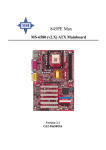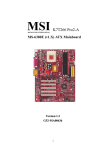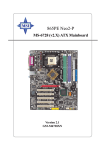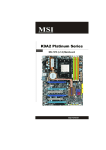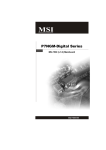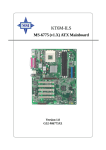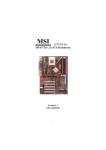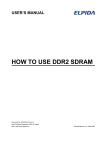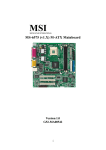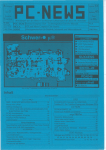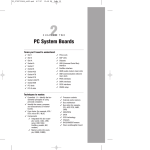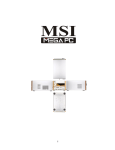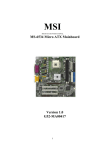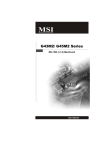Download MSI MS-6566 User's Manual
Transcript
MSI 845 Ultra-C MS-6566 (v1.X) ATX Mainboard Version 1.0 G52-MA00498 i ManualRev: 1.0 Release Date: Dec. 2001 FCC-B Radio Frequency Interference Statement This equipment has been tested and found to comply with the limits for a class B digital device, pursuant to part 15 of the FCC rules. These limits are designed to provide reasonable protection against harmful interference when the equipment is operated in a commercial environment. This equipment generates, uses and can radiate radio frequency energy and, if not installed and used in accordance with the instruction manual, may cause h armful interference to radio communications. Operation of this equipment in a residential area is likely to cause harmful interference, in which case the user will be required to correct the interference at his own expense. Notice 1 The changes or modifications not expressly approved by the party responsible for compliance could void the user’s authority to operate the equipment. Notice 2 Shielded interface cables and A.C. power cord, if any, must be used in order to comply with the emission limits. VOIRLANOTICE D’INSTALLATIONAVANTDERACCORDER AURESEAU. Micro-Star International MS-6566 Tested to comply with FCC Standard For Home or Office Use ii Edition Dec. 2001 Copyright Notice The material in this document is the intellectual property of MICRO-STAR INTERNATIONAL. We take every care in the preparation of this document, but no guarantee is given as to the correctness of its con tents. Our products are under co ntinual improvement and we reserve the right to make changes without notice. Trademarks All trademarks are the properties of their respective owners. Intel® and Pentium® are registered trademarks of Intel Corporation. PS/2 and OS®/2 are registered trademarks of International Business Machines Corporation. Wi nd ows® 95 /9 8/ 20 00 /NT/ XP are regi st ered t rad emarks o f Mi crosoft Corporation. Netware® is a registered trademark of Novell, Inc. Award ® is a registered trademark of Phoenix Technologies Ltd. AMI® is a registered trademark of American Megatrends Inc. Revision History Revision V1.0 Revision History First release iii Date Dec. 2001 Safety Instructions 1. 2. 3. 4. 5. Read the safety instructions carefully. Save this User’s Guide for possible use later. Keep this equipment away from humidity. Lay this equipment on a stable and flat surface before setting it up. The openings on the enclosure are used for air convection and to prevent the equipment from overheating. Note: Do not cover the openings. 6. Make sure that the power voltage is within its safety range and has been adjusted properly to the value of 110/220V before connecting the equipment to the power inlet. 7. Place the power cord in a way that people are unlikely to step on it. Do not place anything on the power cord. 8. Always unplug the power cord before inserting any add-on card or module. 9. All cautions and warnings on the equipment should be noted. 10. Never pour any liquid into the opening that could damage the equipment or cause an electrical shock. 11. If any of the following situations arises, get the equipment checked by a service personnel: l the power cord or plug is damaged l liquid has penetrated into the equipment l the equipment has been exposed to moisture l the equipment has not work well or you can not get it work according to User’s Guide l the equipment was dropped and damaged l the equipment has obvious signs of breakage 12. Do not leave the equipment in an unconditioned environment with a storag e t emp erature o f 6 0 0 C (14 0 0F) or abov e, wh ich may damage t he equipment. CAUT ION: To p revent exp lo si on cau sed by i mp ro per batt ery replacement, use the same or equivalent type of battery recommended by the manufacturer only. iv CONTENTS Chapter 1. Getting Started ................................................................................ 1-1 Mainboard Specification .............................................................................. 1-2 Mainboard Layout ........................................................................................ 1-4 Quick Components Guide ............................................................................ 1-5 MSI Special Features .................................................................................... 1-6 Fuzzy Lo gic™ III .................................................................................... 1-6 PC Alert™ III .......................................................................................... 1-7 D-Bracket™ ............................................................................................ 1-8 Live BIOS™/Live Dri ver™ ................................................................. 1-10 Chapter 2. Hardware Setup ............................................................................... 2-1 Central Processing Unit: CPU ...................................................................... 2-2 CPU Installation Procedures ................................................................ 2-2 Installing the CPU Fan .......................................................................... 2-3 CPU Core Speed Derivation Procedure .............................................. 2-4 Memory ........................................................................................................... 2-5 Introduction to DDR SDRAM ............................................................. 2-5 DDRModule Combination ................................................................... 2-6 Installing DDR Modules ....................................................................... 2-6 Power Supply ................................................................................................. 2-7 ATX 20-Pin Power Connector: JW1 .................................................... 2-7 ATX 12V Power Connector: JPW1 ...................................................... 2-7 Back Panel ...................................................................................................... 2-8 Mouse Connector: JKBMS1 ................................................................ 2-8 Keyboard Connector: JKBMS1 ........................................................... 2-9 USB Connectors .................................................................................... 2-9 Serial Port Connector: COM A & COM B ........................................ 2-10 Joystick/Midi Connectors .................................................................. 2-10 v Audio Port Connectors ...................................................................... 2-10 Parallel Port Connector: LPT1 ............................................................ 2-11 Connectors ................................................................................................... 2-12 Floppy Disk Drive Connector: FDD1 ............................................... 2-12 IrDA Infrared Module Header: JIR1 ................................................. 2-12 Hard Disk Connectors: IDE1 & IDE2 ................................................ 2-13 CD-In Connector: JCD1 ...................................................................... 2-14 Aux Line-In Connector: JAUX1 ........................................................ 2-14 Modem-In Connector: JMD1 ............................................................. 2-14 Fan Power Connectors: CFAN1/SFAN1 .......................................... 2-15 Wake On Ring Connector: JWR1 ...................................................... 2-16 Power Saving Switch Connector: JGS1 ............................................ 2-16 Front Panel Connector: JFP1 & JFP2 ................................................ 2-17 Front Panel Audio Connector: JAUD1 ............................................ 2-18 Front USB Connectors: JUSB1 .......................................................... 2-19 D-Bracket™ Connector: JDB1 ........................................................... 2-20 Jumpers ......................................................................................................... 2-21 Clear CMOS Jumper: JBAT1 .............................................................. 2-21 Slots .............................................................................................................. 2-22 AGP (Accelerated Graphics Port) Slot ............................................. 2-22 PCI Slots ............................................................................................... 2-23 CNR (Communication Network Riser) .............................................. 2-23 PCI Interrupt Request Routing .......................................................... 2-24 Chapter 3. AMI BIOS Setup ............................................................................. 3-1 Entering Setup ............................................................................................... 3-2 Selecting the First Boot Device ........................................................... 3-2 Control Keys .......................................................................................... 3-3 Getting Help ........................................................................................... 3-3 vi The Main Menu ............................................................................................. 3-4 Standard CMOS Features ............................................................................ 3-6 Advanced BIOS Features ............................................................................ 3-8 Advanced Chip set Features ...................................................................... 3-12 Power Management Setup ......................................................................... 3-14 PNP/PCI Configurations ............................................................................. 3-17 Integrated Peripherals ................................................................................. 3-19 Hardware Monitor Setup ............................................................................ 3-22 Load High Performance/BIOS Setup Defaults ........................................ 3-24 Supervisor/User Password ........................................................................ 3-25 IDE HDD AUTO Detection ........................................................................ 3-27 Appendix A: MSI Smart Key .............................................................................A-1 Installing MSI Smart Key ............................................................................A-2 Using MSI Smart Key ..................................................................................A-3 Glossary ................................................................................................................G-1 vii Getting Started Chapter 1. Getting Started Getting Started 1 Thank you for purchasing the MS-6566 v1.X ATX mainboard. The MS6566 v1.X is based on Intel® 845D & ICH2 chipsets for optimal system efficiency. Designed to fit the advanced Intel® Pentium® 4 processors in the 478 pin package, the MS-6566 delivers a high performance and professional desktop platform solution. TOPICS Mainboard Specification Mainboard Layout Quick Components Guide MSI Special Features 1-1 1-2 1-4 1-5 1-6 Chapter 1 Mainboard Specification CPU Support Intel® Pentium® 4 processor in 478 pin package Support 1.3GHz, 1.4GHz, 1.5GHz, 1.6GHz, 1.7GHz, 1.8GHz , 1.9GHz, 2GHz, 2. 2GHz and up* (* not tested yet) Chipset Intel® 845 chipset (593 FC-BGA) - AGP 4x slot (1.5V only) - Support 100MHz FSB - Support 400MHz Intel NetBurst micro-architecture bus Intel® ICH2 chipset (360 EBGA) - AC97 Controller Integrated - 2 full IDE channels, up to ATA 100 - Low pin count interface for SIO Main Memory Support two 184-pin DDR DIMM slots Support up to 2 GB memory size Slots One AGP (Accelerated Graphics Port) 4x slot (1.5V only) Six PCI 2.2v 32-bit Master PCI bus slots One CNR (Communication Network Riser) slot On-Board IDE An IDE controller on the ICH2 chipset provides IDE HDD/CD-ROM with PIO, Bus Master and Ultra DMA66/100 operation modes Can connect up to four IDE devices. Note: The AGP slot DOES NOT support 3.3V AGP card. Use of 3.3V AGP card may cause damage to the mainboard. 1-2 Getting Started On-Board Peripherals On-board Peripherals include: - 1 floppy port supports 2 FDD with 360K, 720K, 1.2M, 1.44M and 2.88Mbytes - 2 serial ports (COM 1 + COM 2) - 1 parallel port supports SPP/EPP/ECP mode - 4 USB ports (Rear x 2/ Front x 2) - 1 Line-In/Line-Out/Mic-In/Game port Audio ICH2 chip integrated AC97 codec supports 2 channel Audio BIOS The mainboard BIOS provides Plug & Play function which detects the peripherals devices and expansion cards of the board automatically The mainboard provides a Desktop Management Interface (DMI) function which records your mainboard specifications Dimension ATX Form Factor 30.5cm x 20cm Mounting 6 mounting holes Others Vcore/Vio adjustable LAN/Modem Wake-up function ACPI support, including STR/STD PC 2001 compliant 1-3 Chapter 1 Mainboard Layout CFAN1 Top : mouse Bottom: keyboard USB ports ATX Power Supply Top : Game port Bottom: Line-Out Line-In Mic JPW1 Codec DIMM 2 AGP Slot PCI Slot 1 SFAN1 JMD1 PCI Slot 2 JAUD1 ICH 2 JBAT1 JAUX1 Winbond W83627HF-AW JCD1 PCI Slot 3 BATT + JGS1 PCI Slot 4 IDE 1 IDE 2 PCI Slot 5 FWH PCI Slot 6 JDB1 FDD1 JIR1 CNR JWR1 JUSB1 845 Ultra-C (MS-6566 v1.X) ATX Mainboard 1-4 JFP2 JFP1 Getting Started Quick Components Guide Component JW1 JPW1 JKBMS1 JKBMS1 USB Connectors COM A & COM B LPT1 FDD1 JIR1 IDE1~ IDE2 JCD1 JAUX1 JMD1 CFAN1/SFAN1 JWR1 JGS1 JFP1/JFP2 JAUD1 JUSB1 JDB1 JBAT1 AGP Slot PCI Slots CNR Slot Function ATX 20-pin power connector ATX 12V power connector Mouse connector Keyboard connector Connecting to USB devices Serial port connector Parallel port connector Floppy disk drive connector IrDA infrared module connector Hard disk connectors CD-in connector Aux line-in connector Modem-in connector Fan power connectors Wake on ring connector Power Saving Switch Front panel connectors Front panel audio connector Front USB connector D-Bracket connector Clear CMOS jumper Connecting to AGP card Connecting to expansion cards Connecting to expansion card 1-5 Reference See p. 2-7 See p. 2-7 See p. 2-8 See p. 2-9 See p. 2-9 See p. 2-10 See p. 2-11 See p. 2-12 See p. 2-12 See p. 2-13 See p. 2-14 See p. 2-14 See p. 2-14 See p. 2-15 See p. 2-16 See p. 2-16 See p. 2-17 See p. 2-18 See p. 2-19 See p. 2-20 See p. 2-21 See p. 2-22 See p. 2-23 See p. 2-23 Chapter 1 MSI Special Features Fuzzy Logic III The Fuzzy Logic III utility allows users to overclock the CPU FSB (Front Side Bus) frequency in the Windows environment. Select the CPU frequency you prefer and click Go to apply the frequency or click Save allowing the system to run at the specified frequency each time when the system is powered on. Features: l Display Current System Status - CPU Fan - CPU Temp. - Vcore - Vio - Memory Clock - CPU Clock - AGP Clock - PCI Clock l Adjust CPU FSB Frequency 1-6 Getting Started PC Alert III The PC AlertTM III is a utility you can find in the CD-ROM disk. The utility is just like your PC doctor that can detect the following PC hardware status during real time operation: * monitor CPU & system temperatures * monitor fan speed(s) * monitor system voltage * monitor chassis intrusion If one of the items above is abnormal, the program main screen will be immediately shown on the screen, with the abnormal item highlighted in red. This will continue to be shown until users disable the warning. Note: Items shown on PC Alert III vary depending on your systems status. 1-7 Chapter 1 D-Bracket (optional) D-Bracket is an external USB bracket integrating four Diagnostic LEDs, which use graphic signal display to help users understand their system. The LEDs provide up to 16 combinations of signals to debug the system. The 4 LEDs can debug all problems that fail the system, such as VGA, RAM or other failures. This special feature is very useful for the overclocking users. These users can use the feature to detect if there are any problems or failures. D-Bracket Green Red D-Bracket 1 3 2 4 Description System Power ON - The D-LED will hang here if the processor is damaged or not installed properly. Early Chipset Initialization Memory Detection Test - Testing onboard memory size. The D-LED will hang if the memory module is damaged or not installed properly. Decompressing BIOS image to RAM for fast booting. Initializing Keyboard Controller. Testing VGA BIOS - This will start writing VGA sign-on message to the screen. 1-8 Getting Started D-Bracket 1 3 2 4 Description Processor Initialization - This will show information regarding the processor (like brand name, system bus, etc ) Testing RTC (Real Time Clock) Initializing Video Interface - This will start detecting CPU clock, checking type of video onboard. Then, detect and initialize the video adapter. BIOS Sign On - This will start showing information about logo, processor brand name, etc . Testing Base and Extended Memory - Testing base memory from 240K to 640K and extended memory above 1MB using various patterns. Assign Resources to all ISA. Initializing Hard Drive Controller - This will initialize IDE drive and controller. Initializing Floppy Drive Controller - This will initializing Floppy Drive and controller. Boot Attempt - This will set low stack and boot via INT 19h. Operating System Booting 1-9 Chapter 1 Live BIOS/Live Driver The Live BIOS & Live Driver is a tool used to detect and update your BIOS and drivers online so that you dont need to search for the correct BIOS or drivers version through the whole web site. To use the function, you need to install the MSI Live Update Series application. After installation, the MSI Live Update Series icon (as the right view) will appear on the screen. Double click the MSI Live Update Series icon, and the following screen will appear. Four buttons are placed on the left column of the screen. Click the desired button to start the update process. l Live BIOS Updates the BIOS online. If your motherboard does not support the function, the sorry message is displayed. l Live Driver Updates the drivers online. If your motherboard does not support the function, the sorry message is displayed. l Live VGA BIOS Updates the VGA BIOS online. If your VGA device does not support the function, the sorry message appears. l Live VGA Driver Updates the VGA driver online. If your VGA device does not support the function, the sorry message is displayed. For more information on the update instructions, insert the companion CD and refer to the Live Update Series Guide under the Manual tab. 1-10 Hardware Setup Chapter 2. Hardware Setup Hardware Setup 2 This chapter provides you with the information about hardware setup procedures. While doing the installation, be careful in holding the components and follow the installation procedures. For some components, if you install in the wrong orientation, the components will not work properly. Use a grounded wrist strap before handling computer components. Static electricity may damage the components. TOPICS Central Processing Unit: CPU Memory Power Supply Back Panel Connectors Jumpers Slots 2-1 2-2 2-5 2-7 2-8 2-12 2-21 2-22 Chapter 2 Central Processing Unit: CPU The mainboard supports Intel® Pentium® 4 processor in the 478 pin package. The mainboard uses a CPU socket called PGA478 for easy CPU installation. When you are installing the CPU, make sure the CPU has a heat sink and a cooling fan attached on the top to prevent overheating. If you do not find the heat sink and cooling fan, contact your dealer to purchase and install them before turning on the computer. CPU Installation Procedures Open Lever 1. Pull the lever sideways away from the socket. Then, raise the lever up to a 90-degree angle. Sliding Plate 2. Look for the gold arrow. The gold arrow should point towards the lever pivot. The CPU will only fit in the correct orientation. Gold Arrow Dot Close Lever 3. Hold the CPU down firmly, and then close the lever to complete the installation. WARNING! Overheating will seriously damage the CPU and system, always make sure the cooling fan can work properly to protect the CPU from overheating. 2-2 Hardware Setup Installing the CPU Fan As processor technology pushes to faster speeds and higher performance, thermal management becomes increasingly important. To dissipate heat, you need to attach the CPU cooling fan and heatsink on top of the CPU. Follow the instructions below to install the Heatsink/Fan: 1. Locate the CPU and its retention mechanism on the motherboard. 2. Position the heatsink onto the retention mechanism. retention mechanism 3. Mount the fan on top of the heatsink. Press down the fan until its four clips get wedged in the holes of the retention mechanism. 4. Press the two levers down to fasten the fan. Each lever can be pressed down in only ONE direction. levers 2-3 Chapter 2 5. Connect the fan power cable from the mounted fan to the 3-pin fan power connector on the board. fan power cable CPU Core Speed Derivation Procedure If CPU Clock Core/Bus ratio then CPU core speed WARNING! = = = = = 100MHz 14 Host Clock x Core/Bus ratio 100MHz x 14 1.4GHz Overclocking This motherboard is designed to support overclocking. However, please make sure your components are able to tolerate such abnormal setting, while doing overclocking. Any attempt to operate beyond product specifications is not recommended. We do not guarantee the damages or risks caused by inadequate operation or beyond product specifications. 2-4 Hardware Setup Memory The mainboard provides 2 slots for 184-pin, 2.5V unbuffered DDR DIMM with 4 memory banks. You can install PC1600/PC2100 DDR SDRAM modules on the DDR DIMM slots (DDR 1~2). To operate properly, at least one DIMM module must be installed. DDR DIMM Slots (DDR 1~2) Introduction to DDR SDRAM DDR (Double Data Rate) SDRAM is similar to conventional SDRAM, but doubles the rate by transferring data twice per cycle. It uses 2.5 volts as opposed to 3.3 volts used in SDR SDRAM, and requires 184-pin DIMM modules rather than 168-pin DIMM modules used by SDR SDRAM. High memory bandwidth makes DDR an ideal solution for high performance PC, workstations and servers. 2-5 Chapter 2 DDR Module Combination You can install either single-sided or double-sided 184-pin DDR DIMM modules into DDR DIMM slots to meet your needs. Different from the SDR DIMM, the DDR DIMM has only one notch on the center of module. The number of pins on either side of the breaks are different. The module will only fit in the right orientation. You can install memory modules in any combination as follows: Slot Momory Module Slot 1 64MB, 128MB, 256MB, (Bank 0 & 1) 512MB, 1GB Slot 2 64MB, 128MB, 256MB, (Bank 2 & 3) 512MB, 1GB Maximum System Memory Supported Total Memory 64MB~1GB 64MB~1GB 64MB~2GB Installing DDR Modules 1. The DDR DIMM has only one notch on the center of module. The module will only fit in the right orientation. 2. Insert the DIMM memory module vertically into the DIMM slot. Then push it in. notch Volt 3. The plastic clip at each side of the DIMM slot will automatically close. 2-6 Hardware Setup Power Supply The mainboard supports ATX power supply for the power system. Before inserting the power supply connector, always make sure that all components are installed properly to ensure that no damage will be caused. ATX 20-Pin Power Connector: JW1 This connector allows you to connect to an ATX power supply. To connect to the ATX power supply, make sure the plugs of the power supply is inserted in the proper orientation and the pins are aligned. Then push down the power supply firmly into the connector. The power connector supports instant power on function which means that system will boot up immediately when the power supply connector is inserted on the board. ATX 12V Power Connector: JPW1 This 12V power connector is used to provide power to the CPU. 11 1 20 10 JPW1 3 4 1 2 JW1 JW1 Pin Definition JPW1 Pin Definition PIN SIGNAL 1 2 3 4 GND GND 12V 12V PIN SIGNAL PIN SIGNAL 1 2 3 4 5 6 7 8 9 3.3V 3.3V GND 5V GND 5V GND PW_OK 5V_SB 10 12V 11 12 13 14 15 16 17 18 19 20 3.3V -12V GND PS_ON GND GND GND -5V 5V 5V 2-7 Chapter 2 Back Panel The Back Panel provides the following connectors: Parallel Mouse Keyboard USB COM A Midi/Joystick COM B L-out L-in MIC Mouse Connector: JKBMS1 The mainboard provides a standard PS/2® mouse mini DIN connector for attaching a PS/2 ® mouse. You can plug a PS/2® mouse directly into this connector. The connector location and pin assignments are as follows: Pin Definition 6 5 3 4 2 1 PS/2 Mouse (6-pin Female) PIN SIGNAL DESCRIPTION 1 2 3 4 5 6 Mouse DATA NC GND VCC Mouse Clock NC Mouse DATA No connection Ground +5V Mouse clock No connection 2-8 Hardware Setup Keyboard Connector: JKBMS1 The mainboard provides a standard PS/2® keyboard mini DIN connector for attaching a PS/2® keyboard. You can plug a PS/2® keyboard directly into this connector. Pin Definition 6 5 3 4 2 1 PS/2 Keyboard (6-pin Female) PIN SIGNAL DESCRIPTION 1 2 3 4 5 6 Keyboard DATA NC GND VCC Keyboard Clock NC Keyboard DATA No connection Ground +5V Keyboard clock No connection USB Connectors The mainboard provides a UHCI (Universal Host Controller Interface) Universal Serial Bus root for attaching USB devices such as keyboard, mouse or other USB-compatible devices. You can plug the USB device directly into ths connector. USB Port Description 1 2 3 4 5 6 7 8 USB Ports PIN SIGNAL DESCRIPTION 1 2 3 4 5 6 7 8 VCC -Data 0 +Data0 GND VCC -Data 1 +Data 1 GND +5V Negative Data Channel 0 Positive Data Channel 0 Ground +5V Negative Data Channel 1 Positive Data Channel 1 Ground 2-9 Chapter 2 Serial Port Connector: COM A & COM B The mainboard offers two 9-pin male DIN connectors as serial ports COM A and COM B. The ports are 16550A high speed communication ports that send/receive 16 bytes FIFOs. You can attach a serial mouse or other serial devices directly to them. Pin Definition 1 2 3 4 5 6 7 8 9 9-Pin Male DIN Connectors PIN SIGNAL DESCRIPTION 1 2 3 4 5 6 7 8 9 DCD SIN SOUT DTR GND DSR RTS CTS RI Data Carry Detect Serial In or Receive Data Serial Out or Transmit Data Data Terminal Ready) Ground Data Set Ready Request To Send Clear To Send Ring Indicate Joystick/Midi Connectors You can connect a joystick or game pad to this connector. Audio Port Connectors Line Out is a connector for Speakers or Headphones. Line In is used for external CD player, Tape player, or other audio devices. Mic is a connector for microphones. 1/8 Stereo Audio Connectors Line Out Line In 2-10 MIC Hardware Setup Parallel Port Connector: LPT1 The mainboard provides a 25-pin female centronic connector for LPT. A parallel port is a standard printer port that supports Enhanced Parallel Port (EPP) and Extended Capabilities Parallel Port (ECP) mode. 13 1 14 25 Pin Definition PIN SIGNAL DESCRIPTION 1 2 3 4 5 6 7 STROBE DATA0 DATA1 DATA2 DATA3 DATA4 DATA5 Strobe Data0 Data1 Data2 Data3 Data4 Data5 8 9 10 11 12 13 14 15 16 17 18 19 20 21 22 23 24 25 DATA6 DATA7 ACK# BUSY PE SELECT AUTO FEED# ERR# INIT# SLIN# GND GND GND GND GND GND GND GND Data6 Data7 Acknowledge Busy Paper End Select Automatic Feed Error Initialize Printer Select In Ground Ground Ground Ground Ground Ground Ground Ground 2-11 Chapter 2 Connectors The mainboard provides connectors to connect to FDD, IDE HDD, case, modem, LAN, USB Ports, IR module and CPU/System FAN. Floppy Disk Drive Connector: FDD1 The mainboard provides a standard floppy disk drive connector that supports 360K, 720K, 1.2M, 1.44M and 2.88M floppy disk types. FDD1 IrDA Infrared Module Header: JIR1 This connector allows you to connect to IrDA Infrared modules. You must configure the setting through the BIOS setup to use the IR function. The JIR1 is compliant to Intel Front Panel I/O Connectivity Design Guide. 5 1 6 2 JIR1 JIR1 Pin Definition 2-12 Pin Signal 1 2 3 4 5 6 NC NC VCC5 GND IRTX IRRX Hardware Setup Hard Disk Connectors: IDE1 & IDE2 The mainboard has a 32-bit Enhanced PCI IDE and Ultra DMA 33/66/100 controller that provides PIO mode 0~4, Bus Master, and Ultra DMA/33/66/100 function. You can connect up to four hard disk drives, CD-ROM, 120MB Floppy (reserved for future BIOS) and other devices. These connectors support the provided IDE hard disk cable. IDE 1 IDE 2 IDE1 (Primary IDE Connector) The first hard drive should always be connected to IDE1. IDE1 can connect a Master and a Slave drive. You must configure second hard drive to Slave mode by setting the jumper accordingly. IDE2 (Secondary IDE Connector) IDE2 can also connect a Master and a Slave drive. TIP: If you install two hard disks on cable, you must configure the second drive to Slave mode by setting its jumper. Refer to the hard disk documentation supplied by hard disk vendors for jumper setting instructions. 2-13 Chapter 2 CD-In Connector: JCD1 The connector is for CD-ROM audio connector. Aux Line-In Connector: JAUX1 The connector is for DVD add-on card with Line-in connector. Modem-In Connector: JMD1 The connector is for modem with internal audio connector. JMD1 GND Mono_Out Phone_In JCD1 R GND L JAUX1 R GND L 2-14 Hardware Setup Fan Power Connectors: CFAN1/SFAN1 The CFAN1 (processor fan) and SFAN1 (system fan) support system cooling fan with +12V. It supports three-pin head connector. When connecting the wire to the connectors, always take note that the red wire is the positive and should be connected to the +12V, the black wire is Ground and should be connected to GND. If the mainboard has a System Hardware Monitor chipset on-board, you must use a specially designed fan with speed sensor to take advantage of the CPU fan control. GND +12V SENSOR CFAN1 GND +12V SENSOR SFAN1 Note: 1. Always consult the vendor for proper CPU cooling fan. 2. CPU Fan supports the fan control. You can install the PC Alert utility that will automatically control the CPU Fan speed according to the actual CPU temperature. 2-15 Chapter 2 Wake On Ring Connector: JWR1 This connector allows you to connect to a modem card with Wake On Ring function. The connector will power up the system when a signal is received through the modem card. Pin 1 2 3 4 5 Signal NC GND MDM_WAKEUP NC 5VSB 1 5 JWR1 Power Saving Switch Connector: JGS1 Attach a power saving switch to this connector. Pressing the switch once will have the system enter the sleep/suspend state. Press any key to wake up the system. JGS1 2-16 Hardware Setup Front Panel Connector: JFP1 & JFP2 The mainboard provides two front panel connectors for establishing electrical connection to the front panel switches and LEDs. Users can choose either JFP1 or JFP2. Both JFP1 and JFP2 are compliant with Intel® Front Panel I/O Connectivity Design Guide. 8 SPK 7 + - BUZ P LED S + - GND 2 1 JFP2 (BUZ is optional) 10 9 PWSW LED + + S P HDD + 2 1 JFP2 Pin Definition Pin 1 2 3 4 Signal GND SPKSLED BUZ+ Pin 5 6 7 8 JFP1 Signal PLED BUZNC SPK+ JFP1 Switch/LED Front Panel Electrical Connection PIN SIGNAL DESCRIPTION 1 2 3 4 5 6 7 8 9 HD_LED_P FP PWR/SLP HD_LED_N FP PWR/SLP RST_SW_N PWR_SW_P RST_SW_P PWR_SW_N RSVD_DNU Hard disk LED pull-up to +5V MSG LED pull-up to +5V Hard disk active LED MSG LED pull-up to +5V Reset Switch low reference pull-down to GND Power Switch high reference pull-up to +5V Reset Switch high reference pull-up to +5V Power Switch low reference pull-down to GND Reserved. Do not use. 2-17 RST Chapter 2 Front Panel Audio Connector: JAUD1 You can connect an optional audio connector to the JAUD1 front panel audio connector. The JAUD1 is compliant to Intel® Front Panel I/O Connectivity Design Guide. 1 2 9 10 JAUD1 Pin Definition PIN SIGNAL DESCRIPTION 1 2 3 4 5 6 7 8 9 10 AUD_MIC AUD_GND AUD_MIC_BIAS AUD_VCC AUD_FPOUT_R AUD_RET_R HP_ON KEY AUD_FPOUT_L AUD_RET_L Front panel microphone input signal Ground used by analog audio circuits Microphone power Filtered +5V used by analog audio circuits Right channel audio signal to front panel Right channel audio signal return from front panel Reserved for future use to control headphone amplifier No pin Left channel audio signal to front panel Left channel audio signal return from front panel CAUTION!!! If you dont want to connect to the front audio header, pins 5 and 6, 9 and 10 have to be shorted by jumper caps in order to have signal output directed to the rear audio ports. 2-18 6 10 5 9 Hardware Setup Front USB Connector: JUSB1 The mainboard provides a front Universal Serial Bus connector for you to connect to USB devices. The JUSB1 connector is compliant with Intel® Front Panel I/O Connectivity Design Guide. 2 10 1 9 JUSB1 JUSB1 Pin Definition Pin Description Pin 1 USBPWR 2 Description USBPWR 3 USBP0- 4 USBP1- 5 USBP0+ 6 USBP1+ 7 GND 8 GND 9 NC 10 USBOC 2-19 Chapter 2 D-Bracket Connector: JDB1 The mainboard comes with a JDB1 connector for you to connect to DBracket. D-Bracket is a USB Bracket integrating four LEDs and allows users to identify system problem through 16 various combinations of LED signals. For definitions of 16 signal combinations, please refer to Chapter 1. DBracket. 2 10 1 9 JDB1 Connected to JDB1 Connected to JUSB1 D-Bracket 2-20 Hardware Setup Jumpers The motherboard provides one jumper for you to set the computers function. This section will explain how to change your motherboards function through the use of the jumper. Clear CMOS Jumper: JBAT1 There is a CMOS RAM on board that has a power supply from external battery to keep the data of system configuration. With the CMOS RAM, the system can automatically boot OS every time it is turned on. That battery has long life time for at least 5 years. If you want to clear the system configuration, use the JBAT1 (Clear CMOS Jumper ) to clear data. Follow the instructions below to clear the data: 1 JBAT1 1 1 3 3 Keep CMOS WARNING! Clear CMOS You can clear CMOS by shorting 2-3 pin while the system is off. Then return to 1-2 pin position. Avoid clearing the CMOS while the system is on; it will damage the mainboard. 2-21 Chapter 2 Slots The motherboard provides six 32-bit Master PCI bus slots, one AGP slot and one CNR slot. AGP Slot PCI Slots CNR Slot AGP (Accelerated Graphics Port) Slot The AGP slot allows you to insert the AGP graphics card. AGP is an interface specification designed for the throughput demands of 3D graphics. It introduces a 66MHz, 32-bit channel for the graphics controller to directly access main memory and provides three levels of throughputs: 1x (266Mbps), 2x (533Mbps) and 4x (1.07Gbps). Please note that the AGP slot does not support 3.3V AGP card. Use of 3. 3V AGP card may cause damages to the mainboard. To avoid the risk of causing permanent damages to the mainboard, the AGP slot is protected with MSI electrical routing device. If users have inserted a 3.3V AGP card into the slot, the MSI routing device will disable the computers boot-up system. Remove the 3.3V AGP card and the boot-up system will return to normal. 2-22 Hardware Setup Attention! DO NOT use the following AGP cards which would cause damages to the mainboard. The following list is subject to change without prior notice. Model ATI Xpert2000 ATI Rage Furry Maxx Diamond Monster Fusion Hercules KYRO II 4500 Leadtek Winfast VR300 Matrox Millennium G400 STB 3Dfx VooDoo3 3500TV AGP Chip 3D RAGE 128VR 3D RAGE 128 Pro 3DFX VooDoo Banshee SiS300 G4+MDHA32G 3Dfx VooDoo 3500TV PCI Slots Six PCI slots allow you to insert the expansion cards to meet your needs. When adding or removing expansion cards, make sure that you unplug the power supply first. Meanwhile, read the documentation for the expansion card to make any necessary hardware or software settings for the expansion card, such as jumpers, switches or BIOS configuration. CNR (Communication Network Riser) The CNR slot allows you to insert the CNR expansion cards. CNR is a specially designed network, audio, or modem riser card for ATX family motherboards. Its main processing is done through software and controlled by the motherboards chipset. 2-23 Chapter 2 PCI Interrupt Request Routing The IRQ, abbreviation of interrupt request line and pronounced I-R-Q, are hardware lines over which devices can send interrupt signals to the microprocessor. The PCI IRQ pins are typically connected to the PCI bus INT A# ~ INT D# pins as follows: Order 1 Order 2 Order 3 Order 4 PCI Slot 1 INT A# INT B# INT C# INT D# PCI Slot 2 INT B# INT C# INT D# INT A# PCI Slot 3 INT C# INT D# INT A# INT B# PCI Slot 4 INT D# INT A# INT B# INT C# PCI Slot 5 INT B# INT C# INT D# INT A# PCI Slot 6 INT A# INT B# INT C# INT D# 2-24 AMI BIOS Setup Chapter 3. BIOS Setup AMI BIOS Setup 3 This chapter provides information on the BIOS Setup program and allows you to configure the system for optimum use. You may need to run the Setup program when: An error message appears on the screen during the system booting up, and requests yo u to run SETUP. You want to change the default settings for customized features. TOPICS Entering Setup 3-2 The Main Menu 3-4 Standard CMOS Features 3-6 Advanced BIOS Features 3-8 Advanced Chipset Features 3-12 Power Management Setup 3-14 PNP/PCI Configurations 3-17 Integrated Peripherals 3-19 Hardware Monitor Setup 3-22 Load High Performance/BIOS Setup Defaults 3-24 Supervisor/User Password 3-25 IDE HDD AUTO Detection 3-27 3-1 Chapter 3 Entering Setup Power on the computer and the syst em will start POST (Po wer On Self Test) process. When the message belo w appears on the screen, press <DEL> key to enter Setup. DEL:Setup F11:Boot Menu F12:Network boot TAB:Logo If the message disappears before you respond and you still wish to enter Setu p, restart th e syst em by t urning it OFF and On or p ressing the R ESET button. Yo u may also restart the system by simultaneously pressi ng <Ctrl>, <Alt>, and <Delete> keys. Selecting the First Boot Device You are allowed to select the 1st boot device without entering the BIOS set up u tili ty by pressin g <F1 1>. When the same message as l isted ab ove appears on the screen, press <F11> to trigger the boot menu. The POST messages might pass by too quickly for y ou to respond in time. If so, restart the system and press <F11> after arou nd 2 or 3 seconds to activate the boot menu similar to the following. Select First Boot Device Floppy IDE-0 CDROM : 1st Floppy : IBM-DTLA-307038 : ATAPI CD-ROM DRIVE 40X M [Up/Dn] Select [RETURN] Boot [ESC] cancel The boot menu will list all the bootable devices. Select the one you want to boot from by using arrow keys and then pressing <Enter>. The system will boot from the selected device. The selection will not make ch anges to the settings in the BIOS setup utility, so next time when you power on the system, it will still use the original first boot device to boot up. 3-2 AMI BIOS Setup Control Keys < ↑> Move to the previous item < ↓> Move to the next item <←> Move to the item in the left hand < →> Move to the item in the right hand <Enter> Select the item <Esc> Jumps to the Exit menu or returns to the main menu from a submenu <+/PU> Increase the numeric value or make changes <-/PD> Decrease the numeric value or make changes <F5> Restore the previous CMOS value from CMOS, only for Option Page Setup Menu <F6> Load High Performance Defaults <F7> Load BIOS Setup Defaults <F10> Save all the CMOS changes and exit Getting Help After entering the Setup utility, the first screen you see is the Main Menu. MainMenu The main menu displays the setup categories the BIOS supplies. You can use the arrow keys ( ↑↓ ) to select the item. The on-line description for the selected setup category is displayed at the bottom of the screen. Default Settings The BIOS setup p rogram contai ns two kinds of default settings: the BIOS Setup and High Performance defaults. Bios Setup defaults provide stable but minimal performance settings for all devices and the system, while High Performance defaults prov ide the best system performance but may affect the system stability. 3-3 Chapter 3 The Main Menu Once you enter AMIBIOS SIMPLE SETUP UTILITY, the Main Menu will appear on the screen. The Main Menu di splays twelve configurab le functions and two exit choices. Use arrow k eys to mo ve among t he it ems and press <Enter> to enter the sub-menu. Standard CMOS Features Use this menu for basic system configurations, such as time, date etc. Advanced BIOS Features Use this menu to set up the items of AMI® special enhan ced features. Advanced Chipset Features Use this menu to change the values in the chipset registers and optimize your system’s performance. Power Management Setup Use this menu to specify your settings for power management. PNP/PCI Configurations This entry ap pears if your system supp orts PnP/PCI. 3-4 AMI BIOS Setup Integrated Peripherals Use this menu to specify your settings for integrated peripherals. Hardware Monitor Setup Thi s ent ry sh ows y our PC’s curren t status, and allows you to ad just CPU clock, core voltage, ratio and DDR voltage. Load High Performance Defaults Use this menu to load the BIOS values for the best system performance, but the system stability may be affected. BIOS Setup Defaults Use this menu to load factory default settings into the BIOS for stable system performance operations. Supervisor Password Use this menu to set Supervisor Password. User Password Use th is menu to set User Password. IDE HDDAUTO Dection Use this menu to automatically detect hard drives. Save & Exit Setup Save changes to CMOS and exit setup. Exit Without Saving Abandon all changes and exit setup. 3-5 Chapter 3 Standard CMOS Features The items inside STANDARD CMOS SETUP menu are divided into 9 categories. Each category includes none, one or more setup items. Use the arrow keys to highlight the item you want to modify and use the <PgUp> or <PgDn> keys to switch to the value you prefer. Date This allows you to set the system to the date that you want (usually the current date). The format is <day><month> <date> <year>. day Day of the week, from Sun to Sat, determined by BIOS. Read-only. month The month from Jan. through Dec. date The date from 1 to 31 can be keyed by numeric function keys. year The year can be adjusted by users. Time This allows you to set the system time that you want (usually the current time). The time format is <hour> <minute> <second>. 3-6 AMI BIOS Setup Pri Master/Pri Slave/Sec Master/Sec Slave Press PgUp/<+> or PgDn/<-> to select the hard disk drive type. The specification of hard disk drive will show up on the right hand according to your selection. TYPE SIZE CYLS HEAD PRECOMP LANDZ SECTOR MODE Type of the device. Capacity of the device. Number of cylinders. Number of heads. Write precompensation. Cylinder location of Landing zone. Number of sectors. Access mo de. Floppy Drive A:/B: This item allows you to set the type of floppy drives installed. Available options: Not Installed, 360 K B 5¼, 1.2 MB 5¼, 720 KB 3½, 1.44 MB 3½ and 2.88 MB 3½ . Boot Sector Virus Protection The i tem is to set the Virus Warn ing feat ure for IDE Hard Di sk boot sector protection. When Enabled, BIOS will issue a virus warning message and beep if a write to the boot sector or the partitio n table of the HDD is attemp ted. Setting options: Disabled and Enabled. Note: Thi s feat ure on ly pro tects the boo t sect or, no t the whole hard disk. 3-7 Chapter 3 Advanced BIOS Features Quick Boot Setting the item to Enabled allows the system to boot within 5 seconds since it will skip some check items. Available options: Enabled and Disabled. Full Screen Logo Show This item enables you to show the company logo on the bootup screen. Settings are: Disabled Shows th e POST messages at boot. Enabled Shows a still image (logo) on the full screen at boot. 1st/2nd/3rd Boot Device The items allow you to set the sequen ce of boot d evices where AMIB IOS attempts to load the operating system. The settings are: IDE-0 The system will boot from the first HDD. IDE-1 The system will boot from the second HDD. IDE-2 The system will boot from the third HDD. IDE-3 The system will boot from the fourth HDD. Floppy The system will boot from floppy drive. ARMD-FDD The system will boot from any ARMD device, such 3-8 AMI BIOS Setup ARMD-HDD CDROM SCSI NETWORK BBS-0 BBS-1 BBS-2 BBS-3 Disabled as LS-120 or ZIP dri ve, t hat functio ns as a flo ppy drive. The system will b oot from ARM D device, such as MO or ZIP drive, that functions as hard disk drive. The system will boot from the CD-ROM. The system will boot from the SCSI. The system will boot from the Network drive. The system will boot from the first BBS (BIOS Boot Specification) compliant device. The system will boot from the second BBS (B IOS Boot Specification) compliant device. The system will boot from the third BBS (BIOS Boot Specification) compliant device. The system will boot from the fourth BBS (BIOS Boot Specification) compliant device. Disable this sequence. Note: Available settings for “1st/2nd/3rd Boot Device” vary depending on the bootable d evices you ha ve installed. For example, if you did not install a floppy drive, the setting “Floppy” does not show up. Try Other Boot Devices Setting the option to Yes allows the system to try to boot from other devices if the system fails to boot from the 1st/2nd/3rd boot device. S.M.A.R.T. for Hard Disks This allows you to activate the S.M.A.R.T. (Self-Monitoring Analysis & Reporting Technology) capability for the hard disks. S.M.A.R.T is a utility that monitors your disk status to predict hard disk failure. This gives you an opportunity to move data from a hard disk that is going to fail to a safe place before the hard disk becomes offline. Settings: Enabled and Disabled. BootUp Num-Lock Th is i tem is to set the Num Lock st atus wh en t he syst em i s p owered o n. Setting to On will turn on the Num Lock key when the system is powered on. Setting to Off will allow end users to use the arrow keys on the numeric keypad. Setting options: On and Off. 3-9 Chapter 3 Swap Floppy Setting to Enabled will swap floppy drives A: and B:. Seek Floppy This setting causes the BIOS to search fo r floppy disk d rives at boot t ime. When enabled, the BIOS will activate the floppy disk drives during the boot process: the drive activity light will come on and the head will move back and forth once. First A: will be done and then B: if it exists. Setting options: Disabled, Enabled. Password Check This specifies the type of AMIBIOS password protection that is implemented. Setting options are described below. Option Description Setup The password prompt appears only when end users try to run Setup. Always A password promp t appears ev ery ti me when the computer is powered on or when end users try to run Setup. Boot OS/2 for DRAM > 64MB This all ows you to run t he OS/2 ® operating syst em with DRAM larger than 64MB. When you ch oose No, yo u cann ot run the OS/2 ® operating sy stem with DRAM larger than 64MB. But it is possible if you choose Yes. APIC Function This field i s used t o enable or disable the APIC (Advanced Programmable Interrupt Controller). Due to compliance with PC2001 design guide, the system is able to run in APIC mode. Enabling APIC mode will expand available IRQ resources for the system. Settings: Enabled and Disab led. MPS Table Version This field allows you to select which MPS (Mult i-Processo r Specification) version to be u sed for the operating system. You need to sel ect the MPS version supported by your operating system. To find out which version to use, consult the vendor of your operating system. Settings: 1.4 and 1.1. 3-10 AMI BIOS Setup L1 Cache Cache memory is additi onal memory th at is much faster than conventional DRAM (system memory). When the CPU requests data, the syst em transfers the requested data from the main DRAM into cache memory, for even faster access by the CPU. The setting enables/disables the internal cache (also known as L1 or level 1 cache). Setting to Enabled will speed up the system performance. Flash Protection This function protects the BIOS from accidental corruption by unauthorized users or computer viruses. When enabled, the BIOS' data cannot be changed when attempting to update the BIOS with a Flash utility. To successfully update the BIOS, you'l l need to disable this Flash Protectio n function. Setting options: Disabled, Enabled. System BIOS Cacheable Selecting Enabled allows caching of the system BIOS ROM at F0000h-FFFFFh, resulting in better system performance. However, if any program writes to this memory area, a system error may result. Setting options: Enabled, Disabled. 3-11 Chapter 3 Advanced Chipset Features Note: Change these settings only if you are familiar with the chipset. Configure DRAM Timing by This setting determines whether DRAM timing is controlled by the SPD (Serial Presence Detect) EEPROM on the DR AM module. Setting to SPD enab les CAS# Latency, RAS# Precharge, RAS# to CAS# Delay, and Precharge Delay automatically to be determined by BIOS based on the configurations on the SPD. Selecting Manual allows users to configure these fields manually. CAS# Latency The field controls the CAS latency, which determines the timing delay before SDRAM starts a read command after receiving it. Setting options: 2.5 Clocks, 2 Clocks. 2 Clocks increases system p erformance while 2.5 Clocks prov ides more stable system performance. RAS# Precharge This setting contro ls the number of cycles for Row Address Strobe (RAS) to be allowed to precharge. If insufficient time is allowed for the RAS to accumulate its charge before DRAM refresh, refresh may be i ncomplete and DRAM may fail to retain data. Th is item applies on ly when synchronou s DRAM is 3-12 AMI BIOS Setup installed in the system. Setting options: 2 Clocks, 3 Clocks. RAS# to CAS# Delay When DRAM is refreshed, both rows and columns are add ressed separately. This setup item allows you to determine the timing of the transition from RAS (row address strobe) to CAS (column address strobe). The less the clock cycles, the faster the DRAM performance. Setting options: 3 Clocks, 2 Clocks. Precharge Delay This setting controls the precharge delay, which determines the timing delay for DRAM precharge. Setting options: 5 Clocks, 6 Clo cks, 7 Clocks. DRAM Integrity Mode Select ECC (Error-Checking & Correcting Code) or Non-ECC according to the type of DRAM installed. AGP Aperture Size The field selects t he size of the Accelerated Graphics Port (AGP) apert ure. Aperture is a portion of the PCI memory address range dedicated for graphics memory address space. Host cycles that hit the aperture range are forwarded to the AGP without any translation. Settings: 4MB, 8MB, 16MB, 32MB, 64MB, 128MB, 256MB. DelayedTransaction The chipset has an embedded 32-bit posted writ e buffer to support delayed transactions cycles. Select Enabled to support compliance with PCI specification version 2.1. Settings: Enabled and Disabled. 3-13 Chapter 3 Power Management Setup IPCA Function This item is to activate the ACPI (Advanced Configuration and Power Management Interface) function. If your operating system is ACPI-aware, such as Windows 98SE/2000/ME, select Yes. Available options: Yes and No. ACPI Standby State This item specifies the power saving modes for ACPI function. Options are: S1/POS The S1 sleep mode is a low power state. In this state, no system co ntext is lo st (CPU or chipset) and hardware maintains all system context. S3/STR The S3 sleep mode is a lower power state where the information of system cofigurat ion and op en applications/ files is saved to main memory that remains powered while most other hardware components turn off to save energy. The information stored in memory will be used to restore the system when an “wake up” event occurs. USB Wakeup From S3 This item allows the activity of the USB device to wake up the system from S3 3-14 AMI BIOS Setup (Suspend to RAM) sleep state. Settings: Enabled and Disab led. Mouse Wakeup From S3 This item allows the activity of the mouse to wak e up t he syst em fro m S3 (Suspend to RAM) sleep state. Settings: Enabled and Disab led. Keyboard Wakeup From S3 This item allows the activity of the keyboard to wake up the system from S3 (Suspend to RAM) sleep state. Settings: Enabled and Disab led. Specific Key for Wakeup This setting allows users to set a specific key for the Keyboard Wakeup From S3 function. PowerManagement/APM Settin g to Enabl ed wil l acti vate an Advanced Power M anagement (APM) device to enhance Max Saving mode and stop CPU internal clock. Settings are Disabled and Enabled. Suspend Time Out (Minute) After the selected period of system inactivity, all devices except the CPU shut off. Settings are Disabled, 1, 2, 4, 8, 10, 20, 30, 40, 50, and 60. FDC/LPT/COM Ports, Primary/Secondary Master/Slave IDE These items specify if the BIOS will monitor the activity of the specified hardware peripheral or component. If set to Monitor, any activity detected on the specified hardware peripheral or comp onent will wake up the system or prevent the system from entering the power saving modes. Settings: Monitor and Ignore. Power Button Function This feature sets the function of the power button. Settings are: On/Off The power button functions as normal on/off button. Suspend When you press the power button, the co mputer enters the suspend/sleep mode, but if the button is pressed for more than four seconds, the computer is turned off. 3-15 Chapter 3 Wake Up On Ring When setting to Enabled, the feature allows your system to be awakened from the power saving modes through an incoming call from the modem. Settings: Enabled and Disabled. Note: You need to install a modem supporting power on function for Wake Up On Ring function. Wake Up On PME When setting to Enabled, the feature allows your system to be awakened from the power savi ng mo des th rough any event on PM E (Po wer Management Event). Settings: Enabled and Disabled. Resume By RTC Alarm This is used to enabl e or disable the feature of booti ng up th e system on a scheduled time/date from the soft off (S5) state. Settings: Enabled and Disabled. RTCAlarm Date/Hour/Minute/Second If Resume By RTC Alarm is set to Enabled, the system will automatically resume (boot up) on a specific date/hour/minute/second specified in these fields. Available settings for each item are: Alarm Date 01 ~ 31, Every Day Alarm Hour 00 ~ 23 Alarm Minute 00 ~ 59 Alarm Second 00 ~ 59 Note: If you change these settings, you must reboot the system until it enters the operating system and then power off the system. By doing so, the changed settings will come into effect next time when you power on the system. PowerAgain This setting specifies whether your system will reboot after a power failure or interrupts occurs. Available settings are: Power Off Leaves the computer in the power off state. Power On Reboots the computer. Last State Restores the system to the status before power failure or interrupt occurs. 3-16 AMI BIOS Setup PNP/PCI Configurations This section describes configuring the PCI bus system and PnP (Plug & Play) feature. PCI, or Personal Computer Interconnect, is a system which allows I/O devices to op erat e at sp eeds nearing th e sp eed the CPU itself uses wh en communicating with its special components. This section covers some very technical items and it is strongly recommended that onl y experienced users should make any changes to the default settings. Clear ESCD The ESCD (Extended System Configuration Data) NVRAM (Non-volatile Random Access Memory) is where the BIOS stores resource information for both PNP and non-PNP devices in a bit string format. When the item is set to Yes, the system will reset ESCD NVRAM right after the system is booted up and then set the setting of the item back to No automatically. PCI VGA Palette Snoop When set to Enabled, multiple VGA devices operating on different buses can han dle d ata from the C PU on each set of p alet te registers on every vi deo device. Bit 5 of the command register in the PCI device configuration space is the VGA Palette Snoop bit (0 is disabled). For example, if there are two VGA devices in the computer (one PCI and one ISA) and the: 3-17 Chapter 3 VGA Palette Snoop Bit Setting Action Disabled Data read or written by the CPU is only d irected to the PCI VGA device’s palette registers. Enabled Data read or written by the CPU is direct ed to both the PCI VGA d evice’s pal ette registers and th e ISA VGA device’s palette registers, permitting the palette registers of both VGA devices to be identical. The set ting must be set t o En abled if any ISA bus adapter in the syst em requires VGA palette snooping. PCI Slot1/6 IRQ, PCI Slot2/5 IRQ, PCI Slot3 IRQ, PCI Slot4 IRQ This item specifies the IRQ line for each PCI slot. Settings: 3, 4, 5, 7, 9, 10, 11 and Auto. Selecting Auto allows BIOS to automatically determine the IRQ line for each PCI slot. DMA Channel 0/1/3/5/6/7 These items specify the bus t hat the syst em DMA (Direct Memory Access) channel is used. The settings determine if AMIBIOS should remove a DMA from the available DM As p assed to devices th at are configurabl e by the sy stem BIOS. The availab le DMA pool i s determined b y reading the ESCD NVRAM. If more DMAs must be removed from the pool, the end user can reserve the DMA by assigning an ISA/EISA setting to it. IRQ 3/4/5/7/9/10/11 These items specify the bus where the specified IRQ line is used. The settings determine if AMIBIOS sh ould remove an IRQ from the pool of available IRQs passed to devices that are configurable by the system BIOS. The available IRQ pool is determined by reading the ESCD NVRAM. If more IRQs must be removed from the IRQ pool, the end user can use these settings to reserv e the IRQ by assig ning an ISA/EIS A setting to i t. Onboard I/O is configured b y AMIBIOS. All IRQs used by on board I/ O are configured as PCI/PnP. If all IRQs are set to ISA/EISA, and IRQ 14/15 are allocated to the onboard PCI IDE, IRQ 9 will still be available for PCI and PnP devices. Available settings: ISA/EISA and PCI/PnP. 3-18 AMI BIOS Setup Integrated Peripherals USB Controller This setting is used to enable/disable the onboard USB controllers. Settings: All USB Port, Disabled, USB Po rt 0&1, USB Po rt 2&3. USB Legacy Support Set to All Device if your need to use any USB device in the operating system that does not support or have any USB driver installed, such as DOS and SCO Unix. Set to No Mice only if your want to use any USB device other than the USB mouse. Setting options: Disabled, No Mice, All Device. On-Chip IDE This setting cont rols the on-chip IDE controller. Setting options: Disab led, Primary, Secondary, Both. AC’97 Audio Auto allows the mainboard to detect whet her an audio device is used. If the device is detected, the onboard AC’97 (Audio Codec’97) controller will be enabled; if not, it is disabled. Disable the controller if you want to use other controller cards to connect an audio device. Settings: Auto, Disabled. AC’97 Modem Auto allows the mainboard to detect whether a modem is used. If a modem is 3-19 Chapter 3 used, the onboard MC’97 (Modem Codec’97) controller will be enabled; if not, it is disabled. Disable the controller if you want to use other controller cards to connect to a modem. Settings: Auto, Disabled. FloppyController This is used to enable or disable the onboard Floppy controller. Option Description Au to BIOS will automatically determine whether to enable the onboard Floppy controller or not. Enabled Enables the onboard Floppy controller. Disabled Disables the onboard Floppy controller. Serial Port A/B These items specify the base I/O port addresses of the onboard Serial Port 1 (COM A)/Serial Port 2 (COM B). Selecting Auto allows AMIBIOS to automatically determine the correct base I/O port address. Settings: Auto, 3F8/COM1, 2F8/COM2, 3E8/COM3, 2E8/COM4 and Disabled. Serial PortB Mode This item sets the operation mod e for Serial Port B. Settin gs: Normal, 1.6uS, 3/16 Baud and ASKIR (the last three operation modes are setting options for IR function). IRDuplex Mode This field specifies a duplex value for the IR device connected to COM B. Full-Duplex mode permits simultaneous two-direction transmission. HalfDuplex mode permits transmission in one direction only at a time. Settings: Half Duplex and Full Duplex. IR Pin Select Set to IRRX/IRTX when using an internal IR module connected to the IR connector. Set to SINB/SOUTB. when connecting an IR adapter to COM B. Parallel Port Thi s fiel d specifies the b ase I/ O port address of the o nboard paral lel po rt. Selecting Auto allows AMIBIOS to automatically determine the correct base I/ 3-20 AMI BIOS Setup O port address. Settings: Auto, 378, 278, 3BC and Disab led. ParallelPort Mode This item selects the operation mode for the onboard parallel port: ECP, Normal, Bi-Dir or EPP. EPP Version The item selects the EPP version used by the parallel port if the port is set to EPP mode. Settings: 1.7 and 1.9. IRQ When Parallel Port is set to Auto, the item shows Auto indicat ing that BIOS determines the IRQ for the parallel port automatically. DMA Channel This feature needs to be configured only when Parallel Port Mode is set to the ECP mode. When Parallel Port is set to Aut o, the field will show Auto indicating that BIOS automatically determines the DMA channel for the parallel port. OnBoardMidi Port The field specifies the base I/O port address for the onboard Midi Port. Midi IRQ Select The item is used to select the IRQ line for onboard Midi port. OnBoard Game Port This item is used to specify the address for the onboard game port. 3-21 Chapter 3 Hardware Monitor Setup This section describes how to set the CPU FSB frequency, monitor the current hardware status including CPU/system temperatures, CPU/System Fan speeds, Vcore etc. Monitor function is available only if there is hardware monitoring mechanism onboard. CPU Ratio Selection This setting controls the multiplier that is used to determine the internal clock speed of the processor relative to the external or motherboard clock speed. CPU FSB Clock (Mhz) This setting allows you to select the CPU Front Si de Bus cl ock frequ ency. Setting options: 100MHz~200MHz at 1MHz increment. SpreadSpectrum When the motherboard clock generator pulses, the extreme values (spikes) of the pulses creates EMI (Electromagnetic Interference). The Spread Spectrum fun ction reduces th e EMI generated b y mod ulati ng the pulses so that the spikes of the pulses are reduced to flatter curves. If you do not have any EMI problem, leave t he set ting at Di sab led for opt imal syst em st abi lit y and performance. But i f you are plagu ed by EMI, sett ing t o En abled for EMI reduction. Remember to disable Spread Spectrum if you are overclocking because even a slight jitter can introduce a temporary boost in clockspeed which 3-22 AMI BIOS Setup may just cause your overclocked processor to lock up. CPU Vcore Adjust This setting is used to adjust the CPU core voltage (Vcore), making overclocking possible. Note: Changing CPU Vcore could result in unstable system; therefore, it is not recommended to change the default setting for long-term purpose. DDR/AGP Power Voltage The it em is to adjust the DDR/AGP vo ltage to i ncrease th e DDR/AGP rate. Modify ing the sett ing may lead to unstabl e system, so changing th e DDR/ AGP Vcore for long-term use is not recommended. CPU/System Temperature, CPU/System Fan Speed, Vcore, 3.3V, +5.0V, +12. 0V, -12.0V, -5.0V, Battery, +5V SB These items di splay the current status of all of th e monitored hardware devices/components such as system voltages, temperatures and fan speeds. 3-23 Chapter 3 Load High Performance/BIOS Setup Defaults The two opt ions on t he main menu allow users t o restore all of t he B IOS settings to High Performance defaults or BIOS Setup defaults. The High Performance Defaults are the default values set by the mai nboard manufacturer for the best system performance but probably will cause a stability issue. The BIOS Setup Defaults are the default values also set by the mainboard manufacturer for stable performance of the mainboard. When you select Load High Performance Defaults, a message as below appears: Pressing ‘Y’ loads the default BIOS values that enable the best system performance but may lead to a stability issue. When you select Load BIOS Setup Defaults, a message as below appears: Pressing ‘Y’ loads the default values that are factory settings for stable system performance. WARNING! The option is for power or overclockin g users only. Use of high performance defaults will tighten most timings to increase the system performance. Therefore, a high-end system configuration is a must, which means you need high-quality VGA adapter, RAM and so on. We don’t recommend that us ers s hould apply the h igh performance defaults in their regular systems. Otherwise, the system may become unstable or even crash. If the system crashes or hangs after enabling the feature, please CLEAR CMOS D ATA to resolve the problem. For more information, refer to “Clear CMOS Jumper:JBAT1” in Chapter 2. 3-24 AMI BIOS Setup Supervisor/User Password When you select Supervisor Password, a message as below will appear on the screen: When you select User Password, a message as below will appear on the screen: Typ e the password, u p to six ch aracters in lengt h, an d press <En ter>. The password typed now will replace any previously set password from CMOS memory. You will be prompted to confirm the password. Retype the password and press <Enter>. You may also press <Esc> to abort the selection and not enter a password. To clear a set password, just press <Enter> when you are prompted to enter the password. A message will show up confirming the password will be disabled. Once the password is disabled, the system will boot and you can enter Setup without entering any password. When a password has been set, you will be prompted to enter it every time you try to enter Setup. This prevents an unauthorized person from changing any part of your system configuration. Addit ionally, when a password is en abled, you can also have AMIBIOS to request a password each time the system is booted. This would prevent unau- 3-25 Chapter 3 thorized use of you r computer. The setting to determine when the password prompt is required is the PASSWORD CHECK option of the ADVANCED BIOS FEATURES menu. If the PASSWORD C HECK opti on is set to Alwa ys, t he password is required both at boot and at entry to Setup. If set to Setup, password prompt only occurs when you try to enter Setup. About Supervisor Password & User Password: Supervisor password: User password: Can enter and change the settings of the setup menu. Can only enter but do not have the right to change the settings of the setup menu. 3-26 AMI BIOS Setup IDE HDD AUTO Detection You can use this u tility to AUTOMATICALLY detect the characterist ics of most hard drives. 3-27 MSI Smart Key Appendix B: MSI Smart Key MSI Smart Key A If security is important to you, the MSI Smart Key is the best solution to prevent your data in the computer from being accessed by unauthorized people. In t he p ub li c workspace, th e passwords (BIOS passwo rd , sy st em password, etc.) are not enou gh to keep your pri vacy. Do you beli eve that a hacker can easily enter your computer and monitor your confidential data? It hap pens everyday, everywhere; yo u just do no t kno w... A password o nly stops them at the first gate. If this protection is broken, what else can you rely on? The M SI Smart Key is a hardware device that p rovides you the complete and perfect protectio n on your system. On ce the key is install ed and setup, any unauthorized user absolutely can not access and use your computer without the key. The computer needs the key to boot up , and the operating system needs t he key to work normally. Furthermore, if you have to leave your desktop for a while, you can simply unplug the key to keep your system in a safest status. TOPICS Installing MSI Smart Key A-2 Using MSI Smart Key A-3 A-1 Appendix A Installing MSI Smart Key Installation Simply follow the few steps below, you can install the Smart Key into your computer very easily. 1. Turn off th e computer. 2. Locate the USB port on your computer. 3. Co nnect t he cab le to the USB po rt, an d th en plu g t he Smart Key into the connector properly. 4. Turn on the computer, and now you can implement this powerful feature. Note: After you have installed the Smart Key into your co mputer, the BIOS will detect it when the system boots up, and you have to enabled/ disabled this function. Furthermore, you should install the dedicated software application in the operating system, which is provided by MSI, to obtain the overall protection on your system. The following sections will provide the detailed instructions for the BIOS setup and software installation. System Requirements Befo re you use th e MSI Smart Key, pl ease ch eck th e hardware, software and operating syst em requirements first. Operating System Windows 98/ME/2000/XP Connector USB port Disk Space At least 2 MB to install the software application A-2 MSI Smart Key Using MSI Smart Key BIOS Setup When the Smart Key is inserted int o your computer, the BIOS will detect it automatically. You can enable or disable th e Smart Key through the BIOS set ting. Pl ease note that i t needs a personalized password to execute any kind of Smart Key setting; so, keep the password firmly in mind. If, unfortunately, the Smart Key is lost or the password is missed, you can not enter the operating system successfully. At this time, contact your local dealer for further service. Enable/ Disable the Smart Key The first time insta llation 1. Insert the Smart Key into the computer and turn on the power. 2. Press <F7 > during system boot up. 3. Th e messag e as b el o w ap p ears on t h e screen ask i n g y o u t o enable or disable the key: Welcome to MSI Smart Key, please press “Y” to begin, press “N” to exit Typ e <Y> t o en abl e i t; t yp e <N> t o d isab l e it an d by p ass th e BIOS to enter t he operatin g syst em. When y ou typ e <Y>, it sh ows the following message: Please input your password and press “Enter” password: A-3 Appendix A 4. Ty pe the password , up to 8 charact ers, and press <Enter>, it wi ll show the following message to ask you confirm the password: Please input your password and press “Enter” Confirm your password: Type the password again and press <Enter>. 5. After th e password is con fi rmed, t he system wi ll generate a set o f rand o m ID, and reco rd t h is ID i nt o t he B IOS R OM an d th e memory ch ip o n t he key ; it wi ll sh ow th e fol l owin g messag e when the Smart Key is enabled successfully: Processing ..... You have enabled the Smart Key Successfully Then, you can enter the operating system and start to work. Note: 1. You should firmly remember the password you set; if the Smart Key is lost, you can get a new key from MSI, and turn on the computer with the original password. 2. To avoid the p assword from being forgotten, we provide the table below for you to keep note in this guide. Please write down the password and keep the guide properly. 3. After the Smart Key function is successfully configured under DOS, the system will automatically reset and enter the installed OS. Please DO NOT unplug the Smart Key unti l the system has entered the OS. A-4 MSI Smart Key Enable/disable Smart Key function 1. Turn on the computer with the Smart Key installed. 2. Press <F7 > during system boot up. 3. Th e messag e as b el o w ap p ears on t h e screen ask i n g y o u t o enable or disable the key: If you want to disable MSI Smart Key, please press “Y”, or press “N” to exit Ty pe <Y> to d isab le it ; ty pe <N> to k eep t he fun cti on enabl ed an d en ter th e op erati ng system. Wh en y ou ty pe <Y>, it sho ws the following message: Processing ..... You have disabled the Smart Key Successfully Then, you can enter the operating system and start to work. A-5 Appendix A Boot up with no key /wro ng key/new key installed Once the MSI Smart Key is enabled, always keep the key inserted in the computer. If the key is unplugged, the other user can not access the computer. The message as below appears during the system booting up: No MSI Smart Key is Present Please plug in your MSI Smart Key or contact your local distributor for details The user have to find and re-plug the original key into the computer to continue booting up the system. If the wrong key or a new key* is inserted, it will show the message as below on the screen: MSI Smart Key password is wrong Please input your password and press “Enter” password: If the user remember the original password, typing in the password will allow the user to enter the operating system, and the sy stem BIOS will copy the original passwo rd data into the wrong key/new key. Otherwise, the system will halt after entering the wrong password for three times. * If, unfortunately, your Smart Key was lost , you have to purchase a new key from MSI a s a replacement. A-6 MSI Smart Key Software Setup When the Smart Key is in serted in to your computer an d the software application is installed in the operating system, it will serve as a safeguard for your system. When the key is un plugged, the op erating system will enter protectio n status immediately and the mouse and keyboard will b e locked; when the k ey is i nserted again , the o perati ng syst em wil l resume from the protected mode. Installation 1. In st al l th e Smart Key i nt o th e compu ter an d turn on t he p ower to enter the operating system successfully. 2. In sert t h e C D-R OM p ro v i d ed an d t h e set u p p ro g ram wi l l execute automatically. The welcome screen will appear as below: 3. Press [ Next > ] t o start the inst allation. A-7 Appendix A 4. Wh en t he Software Li cense Agreement win do w ap pears on t he screen, press [ Yes ] to continue. Click here 5. C ho o se t h e fo ld er t o in st al l t h e so ftware i n y o u r co mp u t er; simply press [ Next > ] to install it in the default folder. Defaultfolder 6. Wh en t he i nst all at io n is comp l eted , restart t h e co mpu t er as instructed. A-8 MSI Smart Key Using the Software Applica tion 1. When th e prog ram is i n st al led in t he o perat in g sy st em, it wil l embed in the system tray and show an icon as below: Smart Key icon Note: When the Smart Key function is disabled in BIOS, this program will not be launched in the operating system. 2. To l au nch th e p ro gram’s setu p screen , simpl y left-cl ick on t he Smart Key icon in th e system t ray. The program’s set up screen appears as below. Control options Program version Th i s wi n d o w co n t ai n s t h e i nfo rmat i on o f t h e p ro g ram an d t he mai n op t io ns for t h e user t o con trol : Securit y Set ti ng an d Other. A-9 Appendix A Security Setting Thi s o p t io n al lo ws y o u t o l og o n t o Wi nd o ws aut o mat i cal ly. Select the “Auto Login” item and check the “Auto Logon to Windows” item in the Setting Page field to enable the function. Once the function is enabled and set pro perl y, y ou d o no t have t o ty pe t he u ser’s name and p assword everytime when entering Windows. Checkthis In Win dows 2000, it will show the related fiel ds when th e “Auto Lo gon to Wind ows” i s checked, you sh ould fill in the correct information in th ese fields. Enter the information A-10 MSI Smart Key Other This option contains two items: 1) Di sa bl e Screen Sa ver al lo ws y ou t o en ab le/d isab le t he screen saver program when t he system is locked. Checkthis 2) Set Screen When System Lo cked al lo ws yo u to set th e statu s wh en t he Smart Key is un pl ug ged and t he sy st em l ock ed . You can set the monitor to display: a) blank screen b) the retaining screen when the system locked c) MSI Logo The default setting is to show MSI Logo. A-11 Appendix A 3. Press t he “Ap pl y C h an g es” b ut t on to en abl e t h e o pt i on yo u choose. Click here 4. Press th e “bu lb” bu tto n at the ri ght -bo tt om to hid e t he program in the system tray and keep on monitoring the system. Click here 5. Press the “door” button at the right-bottom to exit the program. Click here A-12 MSI Smart Key Removi ng the Software Appli cation To remove the program, follow the steps below: 1. Cl ick and cho ose Settings → Control Panel ; d ou b leclick the Add/Remo ve Programs item to open the “Add /Remove Programs Properties” window. Choose this Click here 2. Sel ect t he “SmartKey” i t em i n t h e fi eld an d cl i ck th e [ Add / Remo v e... ]; wh en i t sh o ws th e d i al o g bo x req u i ri ng y o u r co nfirmat ion , press [ Yes ] t o start remo vin g th e p ro gram as t he on-screen instructions. 3. Restart the computer when the un-installation is completed. A-13 Glossary Glossary Glossary ACPI (Advanced Configuration & Power Interface) This power management specification enables the OS (operating system) to control the amount of power given to each device attached to the computer. Windows 98/98SE, Windows 2000 and Windows ME can fully support ACPI to allow users managing the system power flexibly. AGP (Accelerated Graphics Port) A new, high-speed graphics interface that based on PCI construction and designed especially for the throughput demands of 3-D graphics. AGP provides a direct channel (32-bit wide bus) between the display controller and main memory for high graphics quality and performance. ATX A modern shape and layout of mainboard that supersedes the widely-used Baby AT form factor. It improves many placement of components and makes a more efficient design. BIOS (basic input/output system) On PCs, an essential software that contains all the control code of input/output interface (such as keyboard, disk drives, etc.). It executes hardware test on booting the system, starts the OS, and provides an interface between the OS and the components. The BIOS is stored in a ROM chip. Bus A set of hardware lines within the computer system, through which the data is transferred among different components. In a PC, the term bus usually refers to a local bus that connects the internal components to the CPU and main memory. Cache A special memory subsystem that is used to speed up the data transfer. It stores the contents of frequently accessed RAM locations and the addresses where these data items are stored. Chipset A collection of integrated chips designed to perform one or more related functions. For G-1 Glossary example, a modem chipset contains all the primary circuits for transmitting and receiving data; a PC chipset provides the electronic interfaces between all subsystems. CMOS (complementary metal-oxide semiconductor) CMOS is a widely used type of semiconductor, which features high speed and low power consumption. PCs usually contain a small amount of battery-powered CMOS memory to retain the date, time, and system setup parameters. COM In MS-DOS system, the name of a serial communications port. DOS supports four serial ports. For example, if a modem is connected to one serial port and a serial mouse to another, they are identified as COM1 and COM2. DIMM (dual in-line memory module) A small circuit board that holds memory chips. A SIMM (single in-line memory module) has a 32-bit path to the memory chips whereas a DIMM has 64-bit path. DRAM (Dynamic RAM) A most common type of computer memory. It usually uses one transistor and a capacitor to represent a bit. As the development of technology, the memory type and specification used in computer becomes variety, such as SDRAM, DDR SDRAM, and RDRAM. For further instruction, please see the table below: Dynamic RAM (DRAM) Memory Technologies Type FPM (60,70ns) EDO (50,60,70ns) SDRAM (66MHz) SDRAM (100MHz) SDRAM (133MHz) RDRAM (Direct Rambus) DDR SDRAM (100MHz) DDR SDRAM (133MHz) First Used Clock Rate Bus* Width 1990 1994 1996 1998 1999 1999 2000 2000 25MHz 40MHz 66MHz 100MHz 133MHz 400MHz 100MHz 133MHz 64 bits 64 bits 64 bits 64 bits 64 bits 16 bits 64 bits 64 bits * Memory channel width (64 bits started with 75MHz Pentium) Source: Computer Desktop Encyclopedia G-2 Peak Volts Bandwidth 5v 200 MBps 5v 320 MBps 3.3v 528 MBps 3.3v 800 MBps 3.3v 1.1 GBps 2.5v 1.6 GBps 3.3v 1.6 GBps 3.3v 2.1 GBps Glossary ECC Memory (error correcting code memory) A type of memory that contains special circuitry for testing the accuracy of data and correcting the errors on the fly. IDE (Integrated Drive Electronics) A type of disk-drive interface widely used to connect hard disks, CD-ROMs and tape drives to a PC, in which the controller electronics is integrated into the drive itself, eliminating the need for a separate adapter card. The IDE interface is known as the ATA (AT Attachment) specification. IEEE 1394 A new, high speed external bus standard, also known as FireWire or iLink, which supports data transfer rates of up to 400 Mbps for connecting up to 63 external devices. IrDA (Infrared Data Association) A group of device vendors, including computer, component and telecommunications, who have developed a standard for transmitting data via infrared light waves. This enables you to transfer data from one device to another without any cables. LAN (local area network) A computer network that covers a relatively smaller area, such as in a building or an enterprise. It is made up of servers, workstations, shared resources, a network operating system and a communications link. These individual PCs and devices on a LAN are known as nodes, and are connected by cables to access data and devices anywhere on the LAN, so that many users can share expensive devices and data. LED (light emitting diode) A semiconductor device that converts electrical energy into light. Since it lights up (usually red) when electricity is passed through it, it is usually used for the activity lights on computers component, such as disk drivers. LPT (line printer terminal) Logical device name for a line printer; a name reserved by the MS-DOS for up to three parallel printer ports: LPT1, LPT2, and LPT3. It is frequently used by the OS to identify a printer. G-3 Glossary PCI (Peripheral Component Interconnect) A local bus standard developed by Intel that first appeared on PCs in late 1993. PCI provides plug and play capability and allows IRQs to be shared. The PCI controller can exchange data with the system's CPU either 32 bits or 64 bits at a time. PnP (Plug and Play) A set of specifications that allows a PC to configure itself automatically to work with peripherals. The user can "plug" in a peripheral device and "play" it without configuring the system manually. To implement this useful feature, both the BIOS that supports PnP and a PnP expansion card are required. POST (Power On Self Test) During booting up your system, the BIOS executes a series of diagnostic tests, include checking the RAM, the keyboard, the disk drives, etc., to see if they are properly connected and operating. PS/2 Port A type of port developed by IBM for connecting a mouse or keyboard to a PC. The PS/2 port supports a mini DIN plug containing just 6 pins. Most modern PCs equipped with PS/2 ports so that the special port can be used by another device, such as a modem. USB (universal serial bus) A hardware interface for low-speed peripherals such as the keyboard, mouse, joystick, etc. USB provides a maximum bandwidth of 12 Mbit/sec (Mbps) for connecting up to 127 peripheral devices to PC. USB features hot swap capability and multiple data streams, allows external devices to be plugged in and unplugged without turning the system off. Virus A program or a piece of code that infects computer files by inserting in those files copies of itself. The virus code is buried within an existing program, and is activated when that program is executed. All the viruses are man-made, and often have damaging side effects. G-4





















































































